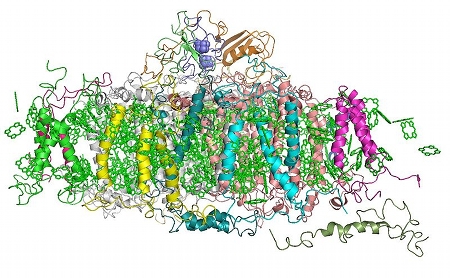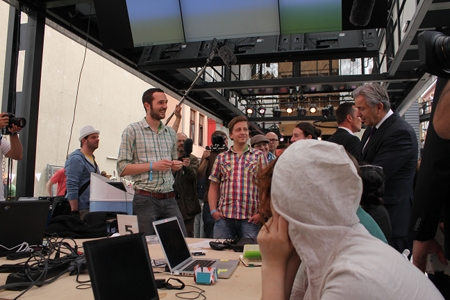au courant au courant
Wednesday, January 9th, 2013the post au courant got a little addition in order to make it more au courant.
randformblog on math, physics, art, and design |
the post au courant got a little addition in order to make it more au courant.

image by Curtis Neveu on wikipedia
About five years ago there was on randform a question regarding the possibility to study the electron transport in a pigment-protein complex via some optical methods in the attosecond regime. Understanding this may be important for the development of new types of solar cells. From the randform post:
It would be interesting to know wether such high temporal resolution could also be used for investigating electron tranfer in pigment-protein complexes such as in a
photosynthetic reaction center (see image above)(correction 05.10.2012: in a FMO complex (the reaction center seems to be a part of this complex)), which was done by researchers in Berkeley e.g. in a 3 pulse two-color electronic photon echo experiment with 750 and 800 nm pulses in the femtosecond range (science 316 (5830)) or wether the high energies of the corresponding laser pulses would alter the corresponding structures, which apparently happenes if one shoots with gamma rays on a pigment.
In a press release which reports about measurements at the photosystem 1 (PS 1) protein (which appears to be even more complex than the above mentioned FMO complex) it seems that one can at least measure the speed of charges in a photosystem with the help of optical devices.
Not only the press release but even the article itself:
Photocurrent of a single photosynthetic protein, by Daniel Gerster, Joachim Reichert, Hai Bi, Johannes V. Barth, Simone M. Kaniber, Alexander W. Holleitner, Iris Visoly-Fisher, Shlomi Sergani & Itai Carmeli
is actually still currently available on the nature nanotechnology website.
The results of their research makes the researchers write (see article):
Our results demonstrate that individual PS I units can be integrated and selectively addressed in nanoscale photovoltaic devices while retaining their biomolecular functional properties. They act as light-driven, highly efficient single-molecule electron pumps that can function as current generators in nanoscale electric circuits.
Instead of directly shooting with lasers the researchers were here however “exciting the PS 1 with a “633 nm laser light with a power of ~4 mW “from the back of the tip” (see figure 1 in the article), which I understand as that the laser light went through the glass of the tip of a scanning near-field optical microscope before it entered the PS 1 (the PS 1 was “glued” via cysteine mutation groups to the glass tip). Moreover the light makes electrons travel through the protein (as I understand with the help of a voltage through the protein i.e. between the tip and the ground) and this can be measured as a current:
The photocurrent was measured by means of a gold-covered glass tip employed in a scanning near-field optical microscopy set-up. The photosynthetic proteins are optically excited by a photon flux guided through the tetrahedral tip that at the same time provides the electrical contact.
The researchers sketched out the whole reaction-centre electron transfer chain and showed electron transfer and recombination times (see figure 2). I didn’t understand where the detailled knowledge for this figure came from, however their measurement seems to be in good agreement with this knowledge, they write:
One of the most significant results in our experiment is the intriguingly large value of ~10 pA for Iphoto. This translates into a turnover time of ~16 ns; in other words, every ~16 ns, an electron transverses the PS I covalently bound between the two electrodes.
(remark: with electrodes the researchers mean here probably the tip and the ground)
The wavelength in the experiment was 633 nm laser light with a power of ~4 mW but I have no feeling how the light is altered by the scanning near-field optical microscope. In particular I still don’t know wether one could use the high resolution laser pulses to investigate the traveling electrons within a photo system without destroying the photo systems.
Because in principle it seems one could make interesting films with this, similar to what had been done for topological insulators.
addition 090113:
It seems there are already some applications underway, which use PS1, which seems also to be up for a patent. I can’t read the original article , but there is some english description e.g. on nanowerk. Found via Sascha Peters on Liligreen.
I haven’t written this explicitly, but may be I should. PS1 is interesting not only because it has a high quantum efficiency (here a current record for quantum efficiency in quantum dots) and because it is usually available in ecofriendly materials like spinach but amongst others also because it seems that the charge carrier separation works rather well. The above work seems to be amongst others probably concerned with studying the involved mechanisms of charge carrier separation, i.e. last but not least it is concerned with the mechanisms of electron transfer.
On that issue I had written five years ago: “electron transfer in the photosynthetic reaction center of Rhodobacter sphaeroides in the above experiment seems to be highly efficient due to the long coherence between the exiton states of two chromophores corresponding to the bacteriochlorophyll b (BChl-b) molecules and bacteriophaeophytin b molecules (BPh) of a photosynthetic reaction center.”” (the comment was based on observations of the Fleming group) but I haven’t found the time and means to look into these mechanisms much further.
addition 24072014:
There is a new article in nature concerned with some of the above questions, in which Serial time-resolved crystallography of photosystem II using a femtosecond X-ray laser is used to investigate the catalytic processes in photosystems. I can’t read the article, but only the abstract and look the images, but that is already quite interesting. In particular concerning the above comment about the correlations one sees in image c how the spatial configuration of the molecules in the electron transfer chain looks like. After the photosystem II primary donor P680 one sees achlorophyll Chl_A and then a pheophytin Pheo_A. In the Wikipedia description of P680 it is written:
The primary donor receives excitation energy either by absorbing a photon of suitable frequency (colour) or by excitation energy transfer from other chlorophylls within photosystem II. During excitation, an electron is excited to a higher energy level. This electron is subsequently captured by the primary electron acceptor, a pheophytin molecule located within photosystem II near P680.
This sounds as if Chl_A is rather in charge of the excitation energy transfer to P680 than as part of the electron transfer from P680 to Pheo_A, which seems different from what the little orange arrows in image c indicates. So a question which arises here is wether one can here observe a long coherence between exiton states of Chl_A and Pheo_A (as it seems it exists for the case of BChl-b and BPh) and wether this involves P680 or not. It seems as if the grid like bubbles in the images g,h,i are eventually charge carrier configurations (? that is those seem to be electron density bubbles upon making a survey on the results of googleing what is an omit map). However I can’t even identify Pheo_A in those images.
addition 19092014:
The question about how the concrete energy transport pathway looks like concretely was raised also on the Azimuth forum
addition 04102017:
I detected an article which explains:
Why Quantum Coherence Is Not Important in the Fenna–Matthews–Olsen Complex
The authors, who apparently use certain Hierarchical equations of motion techniques claim:
Our exact results are then compared to calculations using the incoherent Förster theory, and it is found that the time scale of energy transfer is roughly the same, regardless of whether or not coherence is considered. This means that coherence is not likely to improve the efficiency of the transfer. In fact, the incoherent theory often tends to overpredict the rates of energy transfer, suggesting that, in some cases, quantum coherence may actually slow the photosynthetic process.
Remark: There exists now a Förster resonance energy transfer on Wikipedia, but I don’t know in how far this is related to (incoherent) “Förster theory”.
addition 22092022:
Researchers try to find artificial alternatives to the movements of excitons in plants. Here an approach with polaritons.
( B. Liu et al., “Photocurrent generation following long-range propagation of organic exciton-polaritons,” Optica 9, 1029 (2022).)
Some time ago randform had a blogpost on the mathematical typesetting software LaTeX, however we sofar had not installed LaTeX. On one hand this was due to the fact that until somewhat recently it would have been necessary to install LaTeX on our server for that purpose. Moreover there was sofar no big need to have LaTeX here, because randform hasn’t sofar used too many math formulas. With the tool MathJax, which is offered as a WordPress plugin and with in particular the MathJax possibility to link to a javascript library (which considerably reduces serverspace) we now test the possibility to typeset LaTeX on this blog.
So here as the first typesetting experiment with MathJax: the formula for the suggested function in the petition “Reformvorschläge in der Sozialversicherung”
sideremark: A search with keyword “LaTeX” on openpetition.de, a website which is offering the possibility to launch petitions, which are not allowed on the official petition website of the german parliament (like the above petition) offered just some Google ads with the typical offers you get when you type in latex.

Arduino Workshop at bmwguggenheimlab with Stefan and André
(more…)
The discussion about certain nuclear waste problems which was indirectly adressed in my previous post about mini nuclear reactors went a little further on the blog Azimuth (here, here and here). Connected with the Azimuth blog is the socalled Azimuth project and the Azimuth forum, where amongst others people voluntarily discuss scientific studies on climate and environmental issues and even do some related software projects (like for example this here). So in the comment I suggested that someone could eventually do the necessary calculations to check wether there is a higher cancer rate in the San Francisco Bay area which may be due to a nuclear waste site in the waters close to San Francisco. Likewise one could eventually do similar calculations for the 25000 undersea radioactive waste sites in Russia mentioned in the post about the mini nuclear reactors or to other known sites in the world (see also this post and this comment about sites in India). It would of course also be interesting to hear about related studies.
related randform posts:
->on a recent study of increased risk of cancer in the vicinity of german nuclear power plants
->On the socalled Greiser-study
-> and the general overview on nuclear science posts on randform
Nuclear reactors of smaller sizes like even as small as that they can be buried in the garden and the problem of the traceability of nuclear waste were already mentioned in this randform post with the example of the company Hyperion. So here a little update on the development of some of these reactors:
world nuclear info on small reactors (as of 09 Jan. 12) reports about Hyperions activities in the US:
In March 2010, Hyperion notified the US Nuclear Regulatory Commission that it planned to submit a design certification application in 2012. The company says it has many expressions of interest for ordering units. In September 2010, the company signed an agreement with Savannah River Nuclear Solutions to possibly build a demonstration unit at the Department of Energy site there. (Over 1953-1991, this was where a number of production reactors for weapons plutonium and tritium were built and run.) Hyperion has said it plans to build a prototype by 2015, possibly with uranium oxide fuel if the nitride is not then available.
But Hyperion is not the only small reactor company which is active in the US, apart from the TWR one can read the following in the press release of Babcock & Wilcox Sep. 29 2011:
The Babcock & Wilcox Company (B&W) (NYSE:BWC) and Generation mPower LLC (Generation mPower) will dedicate the unique B&W mPower™ Integrated System Test (IST) facility in Bedford County, Va., at a ceremony today.
…
The IST facility supports further development of the B&W mPower reactor technology that represents a new generation of smaller, scalable nuclear power plants. This world-class testing facility was made possible in part by generous support from the Virginia Tobacco Indemnification and Community Revitalization Commission (TICRC), which provided more than $7 million in grants to support construction of the facility and the purchase of process equipment.
Apart from the testing facility it seems the Tennessee Vallee Authority may be interested in a concrete project.
But the fastet new projects*** are probably HTR-10 versions. According to world nuclear the HTR-10 is a pebble bed reactor – a technology which was more or less abandoned here in Germany, last but not least to the accident at the research facility in Jülich, but seems to have found supporters in China.
Construction of a larger version of the HTR-10, China’s HTR-PM, was approved in principle in November 2005, with construction start in mid 2011.
And since Tsinghua university just opened a new nuclear technology lab this will not be the end of the story.
***There are of course rather old prototypes of small nuclear reactors, like there is according to world nuclear:
Already operating in a remote corner of Siberia are four small units at the Bilibino co-generation plant. These four 62 MWt (thermal) units are an unusual graphite-moderated boiling water design with water/steam channels through the moderator. They produce steam for district heating and 11 MWe (net) electricity each. They have performed well since 1976, much more cheaply than fossil fuel alternatives in the Arctic region.
And there are of course other reators and other small reactors like in submarines some of them performed so well that Russia reports 25,000 undersea radioactive waste sites.
 “verticalized overhead power line with book lover using excessive light”, fotography of the Sony Center court yard on Potsdamer Platz by Loretta (see also the randform post chains)
“verticalized overhead power line with book lover using excessive light”, fotography of the Sony Center court yard on Potsdamer Platz by Loretta (see also the randform post chains)
I was recently looking a bit into the issue of smart grids and ran over an interesting european strategy analysis.
In 2005 the european smartgrid platform www.smartgrids.eu was set up. On their document page the currently newest document linked to is from 2010, it is a Strategic Deployment Document for Europe’s electricity networks of the future (2010) on page 53 one finds:
Engineering in the energy sector, electricity grids in particular, is seen by many as old- fashioned and “difficult” as it requires a high level of competence in mathematics, physics and other sciences. This discourages the potential new students from studying and pursuing a career in power engineering.
… and
All stakeholders in the electricity sector have a responsibility to improve the image of the sector, e.g. by engaging with educational institutions and explaining in an understandable way the real benefits of being involved with and able to deliver solutions to the energy, climate and environmental challenges of today.
This sounds very much as if the major problem of getting new working force for the electricity high-tech sector is mainly a question of hipness. In part it may be true that science and math is regarded as highly “unhip” in certain circles (and the reasons for this are manifold), however the comment in the document seems to miss somewhat a crucial point. Or maybe lets say it sounds a bit strange in the view that even fields medallists in e.g. Great Britain or France try to politely point out that there is structurally something at odds with the whole european science and math research and education.
Happy holidays to all randform readers!
supplement 1.1.2012: a happy new year to all randform readers!

“Biquiertes Iodîner” artwork by Worthülsenfrüchtchen.
There had been low level traces of radioactive Iodine 131 in Europe these days. According to Reuters :
Germany’s Environment Ministry said slightly higher levels of radioactive iodine had been measured in the north of the country, ruling out that it came from a nuclear power plant.
Likewise
Austria’s Environment Ministry said small levels were measured in the east and north of the Alpine country, saying the estimated dose level for the population was one 40,000th of the dose of radiation received in a transatlantic flight.
The source of the radioactivity hasn’t sofar been identified. The IAEA thinks they are not caused by Fukushima. Again according to Reuters:
Massimo Sepielli, head of the nuclear fission unit of Italy’s national alternative energy body ENEA said any number of sources could be to blame for the readings.
“It could be coming from the transporting of (nuclear) material, it could come from a hospital … it could even come from a nuclear submarine, even if it’s a more complicated possibility … but you can’t rule that out.”
I am asking myself now how big a hospital dump must have been in order to find traces which are extending from the east of Austria to northern Germany.
For commemorating the atomic bombings of Hiroshima and Nagasaki two links to recent comments, which I left on the blog Azimuth. One link is to a comment to the new scientist article article “The carbon cost of Germany’s nuclear ‘Nein danke!’ ” where I try to explain why the authors arguments that Germany’s renunciation of commercial nuclear power generation leads to more carbon output are flawed.
A second comment is related to the Manhattan project itself but also to the dangers of biotechnology.
My talk at the open knowledge confence was well perceived, however on the other hand there were not so many participants listening to my talk. In general it seemed to me that games were not (yet) in the focus of the open knowledge community. That is tere were not so many talks involving games at the conference. Nevertheless there were enough issues of importance and the conference was fun.
The slides of my talk are currently too big for upload, so I only uploaded a newer version of the article.
update (130711): The slides are available now at slideshare.net:
Talk: “Testing new toy economies/political structures in MMOGs” at slideshare.net